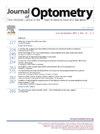Optimizing IOL calculation in triple-DMEK: Data from a real-life cohort
IF 1.8
Q2 OPHTHALMOLOGY
引用次数: 0
Abstract
Purpose
To enhance the accuracy of intraocular lens (IOL) power calculation in patients with Fuchs’ endothelial corneal dystrophy (FECD) undergoing simultaneous cataract surgery and Descemet membrane endothelial keratoplasty (triple-DMEK) by predicting corneal power changes.
Methods
Observational ambispective monocentric cohort study. A linear corneal change model (LCCM) was developed to predict corneal change from the preoperative corneal ratio (anterior/posterior radius). LCCM was validated by comparing prediction errors with the traditional IOL optimization method.
Results
97 eyes of 69 patients were analyzed. Preoperative keratometry was biometrically unmeasurable in 9 eyes, so manually entered autorefractometer data were used for IOL calculations and were analyzed separately. Mean absolute error (MAE) in the manual group (1.35 D (-1.04, 3.75)) was higher than the measured group (0.75 D (-0.62, 2.12)). The median change in simulated keratometry (SimK) was -0.21 ± 0.68 D and in total keratometry (TK) was -0.62 ± 1.09 D (p < 0.001). SRKT outperformed the rest with constant optimization (0.60 D (-0.53, 1.74)). LCCM showed similar MAE to the constant optimization method (p > 0.05). However, MAE for the optimization method was higher (2.08 D (1.77, 2.39)) than LCCM method (1.87 D (1.62, 2.12)).
Conclusions
SimK and TK change significantly after Triple-DMEK. The LCCM could reduce extreme refractive surprises by assisting surgeons in the individualized selection of the best IOL for each eye based on the expected corneal change. Study limitations include variability in FECD severity and the inherent limitations of biometric formulas applied to non-standard eyes. Further studies are recommended.
优化三dmek的人工晶状体计算:来自现实生活队列的数据
目的通过预测Fuchs角膜内皮性营养不良(FECD)患者同时行白内障手术和Descemet膜内皮角膜移植术(3dmek)时角膜度数变化,提高人工晶状体(IOL)度数计算的准确性。方法采用观察性双视角单中心队列研究。建立线性角膜变化模型(LCCM),从术前角膜比值(前/后桡骨)预测角膜变化。通过与传统人工晶状体优化方法的预测误差比较,验证了LCCM的有效性。结果对69例患者的97只眼进行了分析。术前有9只眼的角膜测量无法进行生物测量,因此使用人工输入的自动屈光计数据进行人工晶状体计算并单独分析。手工组的平均绝对误差(MAE)为1.35 D(-1.04, 3.75),高于测量组(0.75 D(-0.62, 2.12))。模拟角膜测量(SimK)的中位变化为-0.21±0.68 D,总角膜测量(TK)的中位变化为-0.62±1.09 D (p <;0.001)。SRKT在持续优化条件下的表现优于其他条件(0.60 D(-0.53, 1.74))。LCCM的MAE与常数优化方法相似(p >;0.05)。然而,优化方法的MAE (2.08 D(1.77, 2.39))高于LCCM方法(1.87 D(1.62, 2.12))。结论Triple-DMEK术后simk和TK有明显变化。LCCM可以帮助外科医生根据预期的角膜变化为每只眼睛选择最佳的人工晶状体,从而减少极端的屈光意外。研究的局限性包括FECD严重程度的可变性和应用于非标准眼睛的生物识别公式的固有局限性。建议进一步研究。
本文章由计算机程序翻译,如有差异,请以英文原文为准。
求助全文
约1分钟内获得全文
求助全文

 求助内容:
求助内容: 应助结果提醒方式:
应助结果提醒方式:


